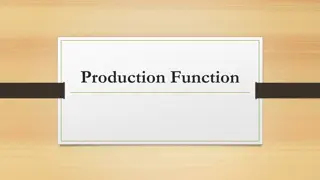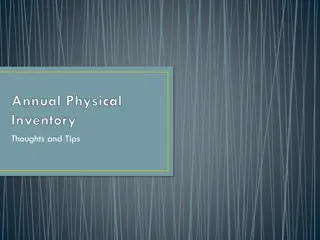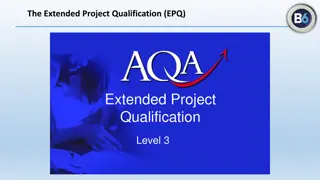Economic Production Quantity (EPQ) Management and Control Inventory
Economic Production Quantity (EPQ) is a concept in inventory management that focuses on determining the optimal batch size for production to minimize total costs. Key assumptions, formulas, and equations related to EPQ are discussed, highlighting the importance of set-up costs, holding costs, and order quantities. The EPQ model provides insights into batch production efficiency, helping businesses streamline their inventory control strategies.
Download Presentation

Please find below an Image/Link to download the presentation.
The content on the website is provided AS IS for your information and personal use only. It may not be sold, licensed, or shared on other websites without obtaining consent from the author.If you encounter any issues during the download, it is possible that the publisher has removed the file from their server.
You are allowed to download the files provided on this website for personal or commercial use, subject to the condition that they are used lawfully. All files are the property of their respective owners.
The content on the website is provided AS IS for your information and personal use only. It may not be sold, licensed, or shared on other websites without obtaining consent from the author.
E N D
Presentation Transcript
Kuliah Managemen Pengendalian Persediaan (Management and Control Inventory) Dosen: Wuryatmo A.Sidik Kuliah 3 Ju mat 30 September 2017
2. Economic Production Quantity EPQ is the quantity of a product that should be manufactured in a single batch so as to minimize the total cost that includes setup costs for the machines and inventory holding costs. Production done in batches or lots Capacity to produce a part exceeds the part s usage or demand rate Assumptions of EPQ are similar to EOQ except orders are received incrementally during production This corresponds to producing for an order with finite production capacity
Economic Production Quantity Assumptions Only one item is involved Annual demand is known Usage rate is constant Usage occurs continually Production rate p is constant Lead time does not vary No quantity discounts
Notations d = daily demand, D = Annual demand p = daily production capacity in units S = set up cost H = Annual holding cost L = Lead time SS = Safety stock No. of operating days per month
Meaning of Q* in EPQ Q* here is still the order quantity (number of units in an order), but now the order is issued to the production department of the same company. Therefore, Q* is actually the production batch size or lot size. 6
Formulas in EPQ D S Total annual ordering cost=TOC= (same as for EOQ) Total annual holding cost =THC Q (1 2 Q 2 (1 ) H p Q d p = ) H is the average inventory level d is the average holding cost 7
Total annual inventory cost D Q d = + S (1 ) H Q 2 p
EPQ atau Q* tercapai pada saat TOC = THC EPQ Formula 2 DS * = Q d 1 ( ) H p
EPQ Equations D I = + Adjusted total cost: MAX 2 TC S H EPQ Q 1 d = Maximum inventory: IMAX Q p 2 DS = EPQ Adjusted order quantity: 1 d H p
EPQ Example Annual demand = 18,000 units Production rate = 2500 units/month Setup cost = $800 Annual holding cost = $18 per unit Lead time = 5 days No. of operating days per month = 20
EPQ Example Solution 18 000 , = = = 1500 / ; 2500 / d units month p units month 12 2 2 18 000 , 800 DS = = = 2000 Q units 1500 d 18 1 1 H 2500 p 1500 d = = = 1 2000 1 800 IMAX Q units 2500 p 18 , 000 800 D I = + = + 800 18 MAX TC S H 2 2000 2 Q = + = , 7 200 , 7 200 14 , 400
EPQ Example Solution (cont.) The reorder point: 1500 = = = 5 375 R dL units 20 With safety stock of 200 units: 1500 = + = + = 5 200 575 R dL SS units 20
EPQ example Demand, D = 12,000 computers per year. p=20,000 per year. Holding cost, H = 100 per item per year. Fixed cost, S = $4,000/order. Find EPQ. EPQ = EOQ*sqrt(p/(p-D)) =979.79*sqrt(20/8)=1549 computers
3. All unit quantity discount Cost/Unit Two versions Constant H Proportional H $3 $2.96 $2.92 5,000 10,000 Order Quantity
3.1.Total Cost with Constant Carrying Costs TCa TCb Total Cost Decreasing Price TCc Annual demand*discount EOQ Quantity
Example Scenario 1 Price a > Price b > Price c Total Cost a b c TCa TCb TCc Q*=EOQ Quantity
Example Scenario 2 Price a > Price b > Price c Total Cost a b c TCa TCb TCc EOQ Q* Quantity
Example Scenario 3 Price a > Price b > Price c a b c Total Cost TCa TCb TCc EOQ Q* Quantity
Example Scenario 4 Price c > Price a > Price c a b c Total Cost TCc TCa TCb Q*=EOQ Quantity
3.1. Finding Q with all units discount with constant holding cost Note all the price ranges have the same EOQ. Stop if EOQ=Q1 is in the lowest cost range (highest quantity range), otherwise continue towards quantity break points which give lower costs Total Cost Q 2 DS 1= H 1 2 Quantity
All-units quantity discounts Constant holding cost A popular shoe store sells 8000 pairs per year. The fixed cost of ordering shoes from the distribution center is $15 and holding costs are taken as $12.5 per shoe per year. The per unit purchase costs from the distribution center is given as C3=60, if 0 < Q < 50 C2=55, if 50 <= Q < 150 C1=50, if 150 <= Q where Q is the order size. Determine the optimal order quantity.
Solution There are three ranges for lot sizes in this problem: (0, q2=50), (q2=50, q1=150) (q1=150,infinite). Holding costs in all there ranges of shoe prices are given as H=12.5, EOQ is not feasible in the lowest price range because 138.6 < 150. The order quantity q1=150 is a candidate with cost TC(150)=8000(50)+8000(15)/150+(12.5)(150)/2 =401,900 Let us go to a higher cost level of (q2=50, q1=150). EOQ=138.6 is in the appropriate range, so it is another candidate with cost TC(138.6)=8000(55)+8000(15)/138.6+(12.5)(138.6)/2 =441,732 Since TC(150) < TC(132.1), Q=150 is the optimal solution. Remark: In these computations, we do not need to compute TC(50), why? Because TC(50) >= TC(138.6). ( 2 15 8000 )( ) = = 138 6 . EOQ 12 5 .
3.2. Summary of finding Q with all units discount with proportional holding cost Note each price range has a different EOQ. Stop if Q1= EOQ of the lowest price feasible Otherwise continue towards higher costs until an EOQ becomes feasible. In each price range, evaluate the lowest cost. Lowest cost is either at an EOQ or price break quantity Pick the minimum cost among all evaluated Total Cost 2 DS Q = 1 H 1 Example: Q1 feasible stop 1 Quantity
3.2. Finding Q with all units discount with proportional holding cost Total Cost 2 DS Q = 1 H 1 2 Example: Q1 infeasible, Q2 feasible, Break point 1 is selected since TC1 < TC2 1 2 DS Quantity Q = 2 H 2
3.2. Finding Q with all units discount with proportional holding cost Stop if 1 is feasible, otherwise continue towards higher costs until a EOQ becomes feasible. Evaluate cost at all alternatives Total Cost 1 2 Quantity
All-units quantity discounts Proportional holding cost A popular shoe store sells 8000 pairs per year. The fixed cost of ordering shoes from the distribution center is $15 and holding costs are taken as 25% of the shoe costs. The per unit purchase costs from the distribution center is given as C3=60, if 0 < Q < 50 C2=55, if 50 <= Q < 150 C1=50, if 150 <= Q where Q is the order size. Determine the optimal order quantity.
Solution There are three ranges for lot sizes in this problem: (0, q2=50), (q2=50, q1=150) (q1=150,infinite). Holding costs in there ranges of shoe prices are given as H3=(0.25)60=15, H2 =(0.25)55=13.75 H1 =(0.25)50=12.5. EOQ1 is not feasible because 138.6 < 150. The order quantity q1=150 is a candidate with cost TC(150)=8000(50)+8000(15)/150+(0.25)(50)(150)/2 =401,900 Let us go to a higher cost level of (q2=50, q1=150). EOQ2=132.1 is in the appropriate range, so it is another candidate with cost TC(132.1)=8000(55)+8000(15)/132.1+(0.25)(55)(132.1)/2 =441,800 Since TC(150) < TC(132.1), Q=150 is the optimal solution. We do not need to compute TC(50) or EOQ3, why? ( 2 15 8000 )( ) = = 132 1 . EOQ 2 13 . 75 ( 2 15 8000 )( ) = = 138 6 . EOQ 1 12 5 .
Types of inventories (stocks) by function Deterministic demand case Anticipation stock For known future demand Cycle stock For convenience, some operations are performed occasionally and stock is used at other times Why to buy eggs in boxes of 12? Pipeline stock or Work in Process Stock in transfer, transformation. Necessary for operations. Students in the class Stochastic demand case Safety stock Stock against demand variations























